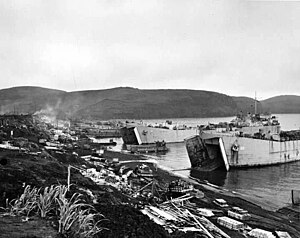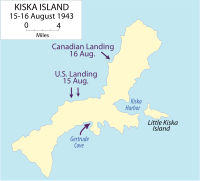Operation Cottage
| Operation Cottage | |
|---|---|
 | |
| Objective | Forcibly remove Japanese forces from Kiska |
| Date | August 15, 1943 |
| Executed by | Allied forces, including the United States and Canada |
| Outcome | Allies secure Kiska unopposed |
| Casualties | 122 military personnel killed, 1 destroyer damaged |
Operation Cottage was a tactical maneuver during the Aleutian Islands campaign. In the operation, which took place on August 15, 1943, Allied military forces landed unopposed on Kiska Island, which had been occupied by Japanese forces since June, 1942. The Japanese forces, however, had secretly abandoned the island two weeks prior. The operation completed the Aleutian Islands campaign.
Japanese invasion
Captain Takeji Ono landed on Kiska at approximately 01:00 on June 7, 1942, with a force of about 500 Japanese marines. Soon after arrival, they stormed an American weather station. Here they killed two and captured eight United States Navy officers. The remaining eight were sent to Japan as prisoners of war.
Another 2,000 Japanese troops arrived, landing in Kiska Harbor. At this time, Monzo Akiyama, a Rear-Admiral, headed the force on Kiska.
In December 1942, additional anti-aircraft units, engineers, and a negligible number of reinforcement infantry arrived on the island.
In the spring of 1943, control was transferred to Kiichiro Higuchi.
Allied reaction

A B-24 aircraft sighted Japanese ships in Kiska. No further identification was visible. To United States naval planners, none was necessary. The orders to invade Kiska soon followed.
Because of the bloodbath at Attu Island, planners were expecting another. The Japanese tactical planners, however, realized the isolated island was no longer protectable and planned for an evacuation.
Although small, there were signs of Japanese retreat. Anti-aircraft guns, once active during the Kiska Blitz, were silent when Allied planes flew over days previous to invasion.
On August 15, 1943, the 7th Division (U.S.) and the 13th Infantry Brigade (Canada), landed on opposite shores of Kiska.
Gunshots, largely friendly fire, killed 24.[citation needed] A Japanese stray mine caused the USS Abner Read (DD-526) to lose a large chunk of its stern. The blast killed 71. Forty-seven troops went missing during the two-day stay on the island and presumably also died from friendly fire. Four other troops had also been killed by landmines or other traps.
Notes
References
- Feinberg, Leonard (1992). Where the Williwaw Blows: The Aleutian Islands-World War II. Pilgrims' Process, Inc. ISBN 0-9710609-8-3.
{{cite book}}: Cite has empty unknown parameter:|coauthors=(help) - Garfield, Brian The Thousand Mile War, Aurum Press, 1995 ISBN 1-84513-019-7
- Goldstein, Donald M. (1992). The Williwaw War: The Arkansas National Guard in the Aleutians in World War. Fayettville, Arkansas, USA: University of Arkansas Press. ISBN 1-55728-242-0.
{{cite book}}: Unknown parameter|coauthors=ignored (|author=suggested) (help) - Morison, Samuel Eliot (1951 (Reprint 2001)). Aleutians, Gilberts and Marshalls, June 1942-April 1944, vol. 7 of History of United States Naval Operations in World War II. Champaign, Illinois, USA: University of Illinois Press. ISBN 0-316-58305-7.
{{cite book}}: Check date values in:|year=(help); Cite has empty unknown parameter:|coauthors=(help) - Perras, Galen Roger (2003). Stepping Stones to Nowhere, The Aleutian Islands, Alaska, and American Military Strategy, 1867 - 1945. Vancouver British Columbia: University of British Columbia Press. ISBN 1-59114-836-7.
{{cite book}}: Cite has empty unknown parameter:|coauthors=(help)
External links
- Logistics Problems on Attu by Robert E. Burks.
- Aleutian Islands Chronology
- Aleutian Islands War
- Aleutian Islands The U.S. Army Campaigns of World War II
- Red White Black & Blue - feature documentary about The Battle of Attu in the Aleutians during World War II
- Soldiers of the 184th Infantry, 7th ID in the Pacific, 1943-1945
- World War II Campaign Brochure for Aleutian Islands, U.S. Army Center of Military History.
- "Kiska".
- The battle for Kiska


